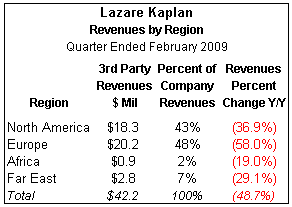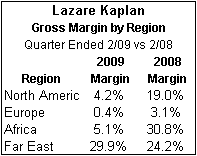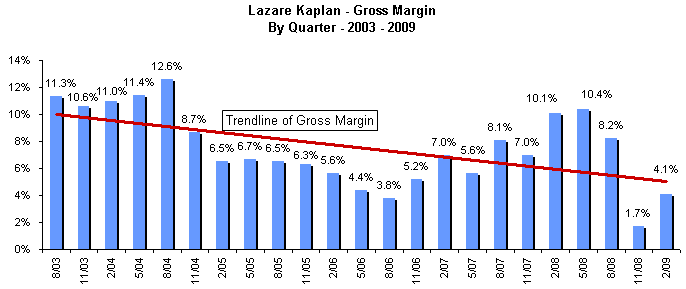IDEX Online Research: Lazare Kaplan’s Europe Market Is Weakest
April 19, 09
Lazare Kaplan reported a disappointing quarter for the fiscal period ended February 2009. Its sales of $42.2 million were only 51 percent of the prior year’s level (sales declined by nearly half), and it posted a large loss – $3.5 million after taxes – in what has historically been one of its strongest quarters of the year. In the prior year, (quarter ended February 2008), Lazare Kaplan’s net profit in the three-month period was $3.3 million, or about 46 percent of the total year’s profit.
The table below summarizes third fiscal quarter financial results (period ended February 2009) for Lazare Kaplan, including a detailed analysis of polished diamond sales and rough diamond sales.

Source: Lazare Kaplan
Europe Sales Weakest
Lazare Kaplan sells its diamonds into four global markets: North America, Europe, Africa and the Far East. In the quarter ended February, Europe was the company’s largest market, accounting for almost half of its revenues. Europe was followed closely by North America (primarily the U.S.), with the Far East and Africa trailing far behind in importance.
Unfortunately, Lazare Kaplan’s largest market – Europe – was also its weakest market in the February quarter. As the table below shows, the company’s sales in Europe to third party unaffiliated customers fell by 58 percent in the quarter. Sales into Africa were down by the least – 19 percent – but they are less than $1 million or only about 2 percent of corporate revenues.

Source: Lazare Kaplan
Lazare Kaplan’s sales trends by global region are reflective of overall industry trends, according to our sources. European demand for jewelry and diamonds has been particularly weak in recent months, while Asian demand has declined more moderately.
Europe Sales Barely Profitable
Not only was Lazare Kaplan’s European market a disappointment in terms of sales, but the company’s gross margin on its sales in that region of the world were also by far the weakest.
The table below illustrates Lazare Kaplan’s quarterly gross margin by global market for the quarter ended February 2009 versus the same quarter a year prior.

Source: Lazare Kaplan
Unfortunately, the gross margin decline in the February quarter is indicative of the company’s long term gross margin trend – weakening. The graph below illustrates Lazare Kaplan’s gross margin by quarter since 2003. The red line is a mathematically calculated trend line for its quarterly gross margin. While there has been some cyclicality to its gross margin, the trend is clear – downward.
An analysis of Lazare Kaplan’s quarterly gross margin on its polished diamond sales versus rough diamond sales reveals the same trend – margins are declining across the board. In part, this is reflective of industry trends. In part, it is due to Lazare Kaplan’s lack of pricing power. The company is a minor competitor in a large market, and it doesn’t have a significant level of market clout. While the company was arguably once the leader in the distribution “ideal cut” diamonds, it has been eclipsed by many other suppliers. The brand clout of the Lazare diamond is simply not strong enough for the company to be able to generate stronger margins via pricing power.

Source: Lazare Kaplan
Corporate Transparency Decreases
Lazare Kaplan has historically been one of the more transparent companies in the diamond and jewelry industry. Not only has the company historically disclosed key news events – some good and some bad – but management has held conference calls with investors to explain the company’s financial and operating results.
Unfortunately, Lazare Kaplan has eliminated investor conference calls, and its latest press releases have been little more than a rehash of some of the high level information found in its legal disclosures. Further, its legal filings fulfill the “letter of the SEC law,” but leave a lot to the imagination in terms of why certain things happened.
Thus, we are able to report what happened in some detail for Lazare Kaplan’s quarter ended February, but answers about why things happened are now more elusive than ever.